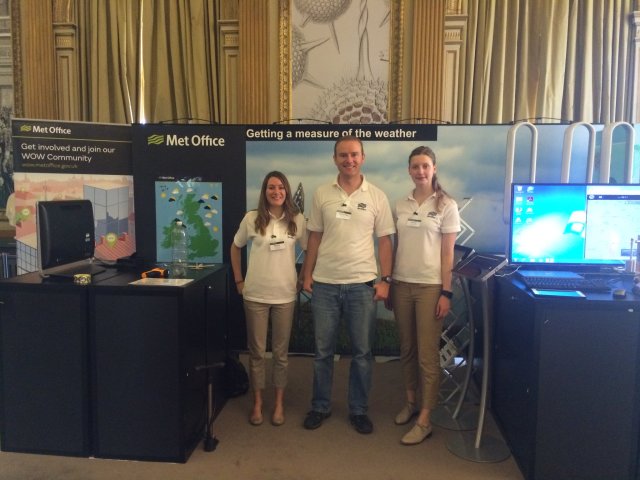The Met Office exhibit at the Royal Society Summer Science Exhibition has been up and running for a couple of days now and runs until Sunday 10 July. Our scientists are busy talking about how we ‘Get a Measure of the Weather’, and explaining some of the innovative ways we can increase our knowledge of the atmosphere. These range from using GPS signals to monitor water vapour and intercepting aircraft signals to better understand the wind.
The current observations networks (including surface observations, aircraft and satellites) are sufficient to provide our supercomputer with the data it requires to deliver a highly accurate forecast. The process by which we ‘feed’ our forecast models, called data assimilation, has been designed to handle the very different coverages and measurement types, and any limitations in our current networks.
The other technology we are talking about at the exhibition is our system for enabling citizen scientists to contribute to our weather monitoring – the Weather Observations Website, or WOW for short. As the forecast models become more advanced in terms of their ability to capture high impact weather on ever smaller scales, additional observations of all kinds help to improve the model further by adding detail to the starting state of the forecast.

We will always require high quality, high resilience operational observing systems. However, we recognise that a range of new measurement devices, including home weather stations, provide the opportunity to increase the amount of data at our disposal, at a relatively low cost. We are keen to explore how we might use these for both feeding our forecast models and for real-time use by our operational meteorologists. One of the ways we can do this is to gather ‘opportunistic’ data that will help us verify the accuracy of the forecast. WOW is designed to work alongside the existing network of observations and to allow the Met Office to gain access to other sources of weather observations, including cars and smartphones.
We are also able to get information about the impact of the weather on people and their daily lives through WOW. Our National Severe Weather Warnings Service provides advice to the public on how the weather will impact them, but without observations to work from we have little knowledge of how effective these warnings have been. WOW provides a way for anyone to share their experiences of how the weather is immediately impacting on them, through sending a photograph into WOW which is automatically checked and provided to our meteorologists.
Meteorological history owes a vast amount to the role of the Voluntary Climate Observers. Many will have heard the phrase ‘since records began,’ and many of those records were started by interested amateur meteorologists, the citizen scientists of their day. This honourable tradition is still with us now and we rely on a dedicated network of Voluntary Climate Observers who send us their readings every day using WOW.
If you would like to find out more about how you could become involved in contributing weather and climate records, please visit our stand at the Royal Society Summer Science Exhibition (RSSSE) at the Royal Society in central London until Sunday 10 July.


Hi Met. Interesting that you have mentioned the already available GPS signal as a potential for atmospheric measurement. You have mentioned a connection with water vapour, but a whole lot more information can be accurately deduced from the radio occultation technique.
As I understand we are on the verge of a new era of satellites which will use the current GPS signals to measure the complete upper atmosphere. The methodology is fairly ‘old school’ being used to remote sense other planetary atmospheres in the ’70’s’. However the physics is robust and dependable.
Occultation uses high speed clocking to measure the temporal delay of a known signal as it bends around a density gradient. The ‘Doppler’ shifted signal can be interpolated to retrieve density from the inverse of Abel’s equation through refractive index. Pressure is deduced from the boundary condition that atmospheric extent is finite and summing density in a column. From the equation of state;
ρT=(P. M)/R
Where ρ is density
T is temperature
P is pressure
M is mean molecular mass
R is the gas constant
If we know what the atmosphere is composed of, we know the density from occultation, as with pressure, and so we know the temperature at that pressure from the equation of state.
Also radio occultation provides an independent measurement of geopotential height independent of geometric.
So we can obtain gradients of;
Density
Pressure
Temperature
Geopotential height
And water vapour, from the present GPS signal.
The advantages are many;
No instrument calibration or drift. All that is measured is time. No difference between detectors. Thousands of measurements per sweep and thousands of sweeps per day with just a few satellites. All with known and dependable accuracy.
Hope this is of interest to some readers.